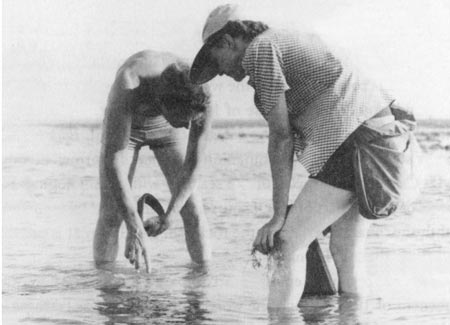
This Article From Issue
September-October 2007
Volume 95, Number 5
Page 457
DOI: 10.1511/2007.67.457
The Gentle Subversive: Rachel Carson, Silent Spring, and the Rise of the Environmental Movement. Mark Hamilton Lytle. x + 273 pp. Oxford University Press, 2007. $23.
Courage for the Earth: Writers, Scientists, and Activists Celebrate the Life and Writing of Rachel Carson. Edited by Peter Matthiessen. viii + 208 pp. Mariner Books. $14.95.
When I set out to read Courage for the Earth, a collection of essays about Rachel Carson edited by Peter Matthiessen, and The Gentle Subversive, a compact life of Carson by Mark Hamilton Lytle, I was more interested in Rachel Carson the writer than in Carson the scientist and environmental activist. (I naively thought I knew a fair amount about the latter from having read Silent Spring.) Of course, I ended up learning quite a lot about both—and much more.

From The Gentle Subversive.
Carson's childhood in small-town western Pennsylvania was relatively sheltered and isolated, despite the fact that her parents were not wealthy. She was the youngest, by eight years, of three children, and her mother was quite protective, although she did allow Rachel to roam the woods near home. An exceptional student, Rachel published her first article (based on a letter from her brother, who was a soldier in Europe during World War I) at age 11, in St. Nicholas, a literary magazine for young readers.
The structure of The Gentle Subversive is based on Carson's major written works, and rightly so. Her first paycheck ($10) was for her writing in St. Nicholas, and English was her first major at Pennsylvania College for Women. By spring of her freshman year she had joined the college newspaper and literary magazine. Sophomore year, however, she took a biology class to satisfy a requirement, and the experience of applying scientific rigor to the natural history her mother had taught her eventually led her to switch majors to zoology. But she remained deeply conflicted: Should she be a writer or a biologist?
Carson's mentor Mary Scott Skinker left the college to pursue a doctorate at Johns Hopkins, and after graduating Carson followed her there to study for her master's degree with a full tuition scholarship and an annual stipend. She completed the degree in 1932, after which the financial burdens of the Great Depression prevented her from continuing her studies. Still, her master's degree in zoology earned her a position as a junior biologist.
Yet Carson didn't leave her writing behind for science. While working as a marine biologist for what would become the Fish and Wildlife Service, she wrote freelance articles about the sea to supplement her income. She eventually rose to become the service's chief editor of publications. By 1952—with success as a writer in the form of a National Book Award for The Sea Around Us—she was able to retire from Fish and Wildlife to devote herself full-time to writing.
Readers who are familiar only with Silent Spring (1962) may be surprised to learn that Carson's earlier books—Under the Sea-Wind (1941), The Sea Around Us (1951) and The Edge of the Sea (1955)—were far more descriptive in nature. After getting a taste of them from the Lytle and Matthiessen books, I'm looking forward to bringing them along on my next beach trip. Carson's motive in writing these volumes about the sea was deeply environmental, yet she endeavored not just to educate but also to captivate the reader. Silent Spring, although gracefully written, was far more polemical. As Lytle notes, "When she decided to write what Dorothy Freeman [a close friend] called the 'poison book,' Rachel Carson committed herself to a crusade, driven on by a sense of moral outrage."
Both Courage for the Earth and The Gentle Subversive are well worth pursuing. The former offers more varied viewpoints—from E. O. Wilson to Al Gore to Carson's main biographer, Linda Lear—whereas the latter provides, necessarily, a tighter, more linear narrative. Both are superb at bringing Rachel Carson's writing, convictions and dedication to life.

American Scientist Comments and Discussion
To discuss our articles or comment on them, please share them and tag American Scientist on social media platforms. Here are links to our profiles on Twitter, Facebook, and LinkedIn.
If we re-share your post, we will moderate comments/discussion following our comments policy.